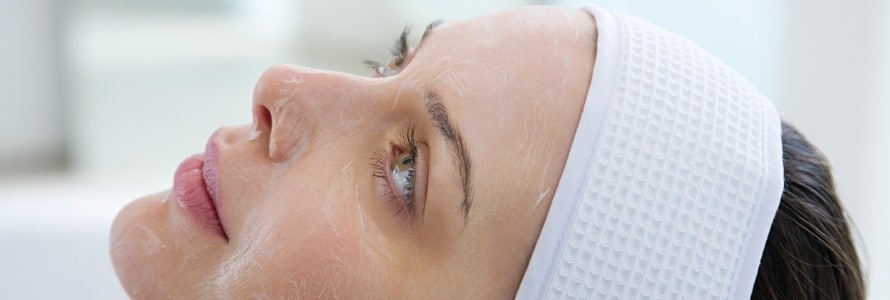
What Do Chemical Peels Treat?
Chemical peels remove damaged outer layers of skin to make skin smoother, reduce scarring and remove blemishes.
Our Approach to Chemical Peel Treatments
During a TCA or phenol peel, the skin is cleansed and the solution is applied, which may cause a brief stinging sensation. Petroleum jelly or a waterproof adhesive tape may be put on the skin following a phenol peel. During an AHA peel, the skin is cleansed and the solution applied; there is no need for post-peel ointment or covering.
What Types of Chemical Peels Are There?
Ranging from mild to strong, there are three types of chemical peel treatments: alphahydroxy acid (AHA), trichloroacetic acid (TCA), and phenol.
What is an Alphahydroxy Acid (AHA) Peel?
An AHA peel is the gentlest of the three types of chemical peels. It contains glycolic, lactic and fruit acids that smooth and brighten skin, and is used to treat fine wrinkles, dryness, uneven pigmentation and acne. An AHA peel is typically applied once a week, or may be mixed in a milder concentration with a cream or cleanser to be used daily. Treatment takes less than 10 minutes.
What is a Trichloroacetic Acid (TCA) Peel?
A TCA chemical peel is commonly used for medium-depth peeling, although depth is adjustable. It treats fine surface wrinkles, superficial blemishes and pigment problems and, in addition to the face, can be used on the neck and other areas of the body. It is sometimes used in combination with an AHA peel. A TCA peel is the preferred peel for darker-skinned patients. Results do not last as long as those of phenol peels, and multiple treatments may be required. However, treatments take only 10 to 15 minutes, and recovery time is shorter.
What is a Phenol Peel?
A phenol peel, which is the strongest chemical peel, treats deeper skin problems such as coarse facial wrinkles and precancerous growths, as well as areas of blotchy or damaged skin caused by sun exposure, aging or birth-control pills. Because phenol can lighten skin where it is applied, the patient's natural pigmentation is a factor in determining a phenol peel's suitability. Phenol is used only on the face because it may cause scarring elsewhere. Full-facial treatment can last an hour or two, and recovery can take a few months, with possible permanent lightening of the skin and removal of freckles.
Is a Chemical Peel Painful?
During a chemical peel, anesthesia is not required because TCA and phenol have anesthetic properties, and AHA produces only a slight stinging.
With a TCA or phenol peel, when the solution is first applied, it may cause a brief stinging sensation. Post-procedure, a TCA or phenol peel can result in tingling or throbbing, reddened skin, a crust or scab, and significant swelling that lasts, depending on the strength of the peel used, about a week.
After a phenol peel, eyes may be swollen shut at first, and the patient may be put on a liquid diet and advised to keep talking to a minimum. After an AHA peel, there may be temporary stinging, redness and irritation, as well as flaking or crusting.
Are There Risks Associated With a Chemical Peel?
All three types of peels carry potential risks that include infection and scarring. In addition to the aftereffects mentioned above, a TCA peel can produce unintended color changes in the skin, and a phenol peel can reduce or eliminate the new skin's ability to make pigment evenly or at all, causing a lighter or uneven skin tone.
Possible side effects include mild to severe redness, temporary tightness, itching, swelling, and skin dryness, similar to sunburn or windburn. These effects typically subside within 2-3 days. If inflammation or irritation occurs, hydrocortisone may be recommended, either by prescription or over-the-counter (such as Vanicream HC®).
How Do I Prepare for a Chemical Peel?
Following pre-peel instructions is key to ensuring your chemical peel is safe, effective, and you achieve the best results. Before your appointment:
- Avoid acidic products, retinoids, and exfoliating scrubs for a week before your appointment.
- During your consultation, be sure to inform your aesthetician of any existing medical conditions or medications you may use, including Accutane.
- Minimize sun exposure, and avoid tanning and hair removal (including shaving, waxing, or tweezing) in the treatment area for at least 2-3 weeks prior to your appointment.
- Avoid Botox and dermal fillers a week before the procedure.
- Do not apply makeup, lotions, or perfumes on the treatment day. Ensure your skin is clean on the day of treatment.
- Bring sun protection to use after the procedure. Your skin will be especially sensitive to harmful UV rays.
- Reschedule if you have a cold sore or other skin infection.
How Do I Care for My Skin After a Chemical Peel?
Taking proper care of your skin after a chemical peel is vital to ensuring you get the best results possible. Because these peels work by essentially speeding up your skin's natural regeneration process, it's important not to do anything that may interfere with or prolong the healing process.
After your chemical peel:
- Expect peeling to last 7-10 days or longer, with redness, sensitivity, and flaking.
- Skin may be rough, patchy, or darken initially; peeling usually starts around the nose and mouth by day 3-4.
- For the first two weeks after your treatment, do not use:
- acidic products such as retinoids or tretinoins
- acne medication products such as Retin-AⓇ, TazoracⓇ, RenovaⓇ, AtralinⓇ, ZianaⓇ, VeltinⓇ, DifferinⓇ
- the antibiotic Doxycycline
- AHAs (lactic, glycolic, tartaric, etc.)
- BHAs (salicylic)
- benzoyl peroxide
- vitamin C products
- lightening agents such as hydroquinone
- any exfoliative products including loofahs or coarse sponges
- Apply cold compresses gently for irritation.
- Avoid excessive heat, sun exposure, and tanning for 4 weeks.
- No strenuous exercise or sweating for 2-3 days.
- Do not use acidic products or exfoliants for 2 weeks.
- Avoid hair removal and cosmetic services for 4 weeks. This includes hair dyeing, as the dyes may interfere with your results.



